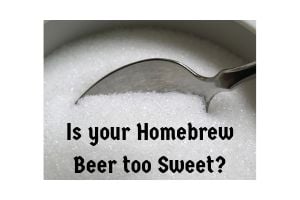If an unexpected flavor of green apples or hard cider has presented itself in your homebrew, you likely have an acetaldehyde problem on your hands. Now that you know what it is, how do you get rid of it?
If your yeast is dormant or dying, you may need to turn to the German art of krausening. This will allow you to rid your brew of acetaldehyde by introducing fresh, healthy yeast to a beer in the middle of fermentation. This new yeast will reinvigorate the fermentation process, ridding you of excess acetaldehyde as well as other unwanted compounds.
Read on to learn all about these remedies and how they work, as well as techniques to avoid an influx of acetaldehyde in the future.
Topics We Cover
Where does acetaldehyde come from in homebrew beer?
Acetaldehyde is a naturally occurring compound found in coffee, fruit, and, yes, homebrew. Much like carbon dioxide and ethanol (alcohol), acetaldehyde (C2H4O) develops naturally during the fermentation process.
During normal fermentation, healthy yeast is converted into alcohol. This normally rids the beer of acetaldehyde, but additional oxidation can also cause it to come back.
Because of this, the presence of acetaldehyde in homebrew typically has one of three root causes:
- The beer has not fully fermented
- The yeast is unhealthy and underperforming
- Over-oxidation has occurred, typically during bottling
What does acetaldehyde taste like in homebrew?
Acetaldehyde is easy to spot.
Its flavor is most commonly compared to the sweet tartness of green apple. In some cases, it may make your beer taste more like a very dry cider.
A bit of acetaldehyde’s appley flavor is often desired in beer styles like Biere de Garde and certain American lagers. But in most cases, it should be fermented out of your brew by the time conditioning is complete. If too much remains after fermentation, undesirable off-flavors may present themselves.
Can you smell acetaldehyde?
In high enough concentrations, acetaldehyde will cause your homebrew to present a green apple odor in addition to the appley flavor.
You can train yourself to spot both the aroma and flavor of acetaldehyde by practicing with green apple extract or even apples themselves.
Getting rid of acetaldehyde in finished beer
Once you detect the presence of acetaldehyde in your beer, you may be wondering if it’s even possible to save. Great news! There are a few things you can try to rescue your struggling brew.
Luckily, there are a few easy tricks for getting rid of it.
In some cases, simply conditioning your beer longer will resolve the issue.
Because most acetaldehyde is converted into alcohol by yeast during the fermentation process, extending your fermentation time gives healthy yeast more time to finish.
It’s possible your brew is “green” or not fully fermented yet. Give your yeast another few days to keep doing their thing and taste again.
If your airlock stops bubbling and the off-flavors of acetaldehyde are still presenting themselves, the next thing to try is a German technique called krausening.
Though the process is not terribly complex, it does involve brewing a second batch of the same recipe you started with. A few days into fermentation, the thick head of bubbles and foam that fills the top of your fermenter is called krausen. When the krausen reaches its peak on the second batch, add it to the first batch.
By boosting your beer with the lively second batch, you can reawaken fermentation in your original brew which will, in turn, ferment out more acetaldehyde.
If your beer still tastes strongly of green apple even after krausening and a full fermentation, it’s best to start over with a new batch. The good news is that there are concrete steps you can take to prevent acetaldehyde off-flavors the next go-round.
How to prevent acetaldehyde off-flavors in your next batch of homebrew
Most homebrewers know that following strict sanitation practices during the brewing process ensures a quality batch.
Maintaining a high standard of sanitation will help prevent acetaldehyde, and a host of other unwanted guests, from showing up in your homebrew.
Particularly after you’ve boiled your wort, be sure to keep everything it comes into contact with clean and sanitized with a bleach solution or commercial sanitizer like Star San.
Even with downright obsessive cleaning standards, acetaldehyde flavors and aromas can still show up when you least expect it. Here are a few other tips for keeping acetaldehyde off-flavors out of your next batch of homebrew:
Allow your homebrew to finish conditioning
Acetaldehyde off-flavors can often be remedied by simply waiting longer.
Because most acetaldehyde is converted into alcohol by yeast during the fermentation process, extending your fermentation time gives healthy yeast more time to finish.
It bears repeating, many homebrewers panic when, after all their hard work, their first sip of homebrew tastes more like hard cider. It’s important at this point not to rack off your yeast until it’s fully finished its job.
Use healthy yeast in your homebrew (and use the right amount!)
We’ve all been there. You stock up on some aspirational brewer’s yeast online or at your local homebrew supply store, and it sits in your fridge for longer than you intended. Remember, yeast are living things! And, like every living thing, they have an expiration date.
Always check your yeast envelope for an expiration date before you use it, pitch the amount that your recipe calls for, and use quality brewers yeast that’s appropriate for the beer style you’re brewing.
Ferment your homebrew at a slightly higher temperature
Another simple thing to consider is the temperature at which your beer has been conditioning.
For ales and most beer styles besides lagers, room temperature is the way to go. But even “room temperature” can fluctuate in certain areas of your house or depending on the time of year.
Avoid leaving your fermenter in a drafty area or even a basement that might get cool at night. These cooler temperatures can cause your yeast to go dormant, leaving acetaldehyde behind in your beer.
Even cold-conditioned beers like lagers can benefit from a slightly warmer finishing temperature if off-flavors have been a problem.
Avoid aeration as soon as fermentation begins
You probably know a bit of gentle aeration can help kickstart the fermentation process once you pitch your yeast. However, after that, leave it alone!
Aeration later in the process can cause more acetaldehyde to develop than your yeast can keep up with. Even carrying your fermenter from room to room or sliding it across the floor can jostle things more than you intend to.
Once you pick the perfect temperate spot, leave it be.
Don’t introduce oxygen to your homebrew during bottling
The same goes for the bottling process.
If you’ve followed all the steps above and are still left scratching your head about appley flavors in your finished product, you may have inadvertently introduced oxygen into your beer during bottling.
Check any lines or hoses you use to transfer the beer into bottles and ensure they have a steady, consistent flow without air pockets.
For the web story version of this article click here!




